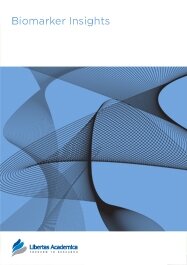

Publication Date: 10 Jun 2008
Journal: Biomarker Insights
Citation: Biomarker Insights 2008:3 335-350

Departments of Medicine and Research Service, Duke University and Durham Veterans Affairs Medical Centers, Durham, North Carolina, U.S.A.
Abstract
Background: Anergy is a key mechanism controlling expression of autoreactive B cells and a major site for failed regulation in autoimmune diseases. Yet the molecular basis for this differentiated cell state remains poorly understood. The current lack of well-characterized surface or molecular markers hinders the isolation of anergic cells for further study. Global gene profiling recently identified transcripts whose expression differentiates anergic from naïve B cells in model mouse systems. The objective of the current study was to evaluate the molecular and cellular processes that differentiate anergic cells that develop in the healthy C57BL/6 (B6) milieu from those that develop in the autoimmune-prone MRL/MpJ (MRL) background. This approach takes advantage of B6 and MRL mice bearing an anti-laminin Ig transgene with a well characterized anergic B cell phenotype.
Results: Global gene expression was evaluated in purified transgenic B cells using Operon version 3.0 oligonucleotide microarray assaying 31,000 oligoprobes. Genes with a 2-fold expression difference in B6 as compared to MRL anergic B cells were identified. Expression of selected genes was confirmed using quantitative RT-PCR. This approach identified 43 probes corresponding to 37 characterized genes, including Ptpn22, CD74, Birc1f/Naip, and Ctla4, as differentially expressed in anergic B cells in the two strains. Gene Ontology classification identified differentiation, cell cycle, proliferation, development, apoptosis, and cell death as prominently represented ontology groups. Ingenuity Pathway Analysis identified two major networks incorporating 27 qualifying genes. Network 1 centers on beta-estradiol and TP53, and Network 2 encompasses RB1, p38 MAPK, and NFkB cell growth, proliferation, and cell cycle signaling pathways.
Conclusion: Using microarray analysis we identified 37 characterized genes and two functional pathways engaged in maintenance of B cell anergy for which expression is distorted by underlying autoimmune genetic susceptibility. This approach identifies a new biological role for multiple genes and potential new therapeutic targets in autoimmunity.
PDF (1.55 MB PDF FORMAT)
RIS citation (ENDNOTE, REFERENCE MANAGER, PROCITE, REFWORKS)
BibTex citation (BIBDESK, LATEX)
XML
PMC HTML

I would like to extend my gratitude for creating the next generation of a scientific journal -- the science journal of tomorrow. The entire process bespoke of exceptional efficiency, celerity, professionalism, competency, and service.

All authors are surveyed after their articles are published. Authors are asked to rate their experience in a variety of areas, and their responses help us to monitor our performance. Presented here are their responses in some key areas. No 'poor' or 'very poor' responses were received; these are represented in the 'other' category.See Our Results
Copyright © 2013 Libertas Academica Ltd (except open access articles and accompanying metadata and supplementary files.)
Facebook Google+ Twitter
Pinterest Tumblr YouTube